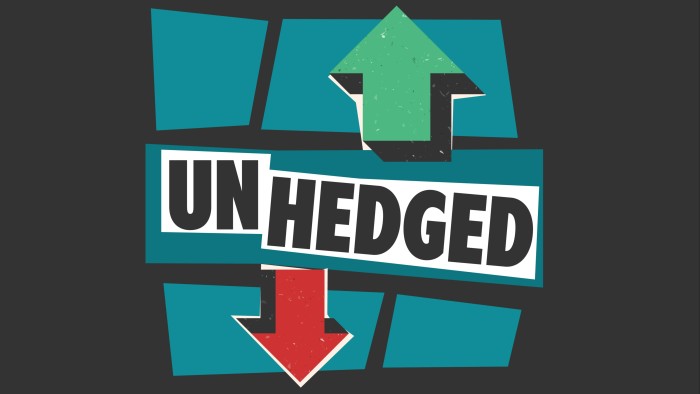This article is an on-site version of our Unhedged newsletter. Premium subscribers can sign up here to get the newsletter delivered every weekday. Standard subscribers can upgrade to Premium here, or explore all FT newsletters
The US Senate passed President Donald Trump’s budget yesterday by the smallest possible margin. Now it’s back to the House of Representatives for final approval, where concerns about the bill’s deficit implications will remain an obstacle. The bond market shrugged off the whole event; the 10-year Treasury yield rose less than 2bp after the bill passed. But the dollar continued to inch lower. Email us: unhedged@ft.com.
The US jobs market
The US payroll report for June lands tomorrow and, because Unhedged will be taking a patriotic holiday on Friday, readers will be deprived of our take on the numbers, at least until Monday. But it is worth revisiting the labour market today, both to provide context for tomorrow and because the data is interesting and remains something of a puzzle.
Most of the hard data on employment paints a picture of solidity and steadiness. Below are new jobs added by month. You have to work pretty hard to make out a rising or falling trend there:

Looking at job openings, hirings, quits and lay-offs reinforces this picture. While openings and hires are a bit lower than two years ago, for the past year they have been very steady:

Both the unemployment rate and the prime age participation rate are equally consistent, and are at strong levels relative to history (4.2 per cent and 83 per cent). All of this supports the Federal Reserve’s view that the job market is strong enough for interest rate cuts to wait until we know more about the effect of tariffs on inflation.
There is one notable piece of hard data that is weakening, though. While initial jobless claims remain low and steady, continuing jobless claims — people entering the ranks of the unemployed and staying there — are low but rising briskly:

Not many people are getting laid off, but those that are laid off are having trouble finding jobs. While these numbers are not big enough to hit the overall employment picture, the trend here is ugly enough to keep an eye on.
Let’s turn to the soft — that is, survey-based — data, which tells a different story. Responding to the job openings data yesterday, Sam Tombs of Pantheon Macro wrote:
The jump in total job postings is irreconcilable with a broad range of other evidence showing waning appetite among businesses to hire more workers. Indeed’s measure of total job postings on June 20 was 1 per cent lower than four weeks previously, while the hiring intentions indices of the NFIB [National Federation of Independent Business] and regional Fed business surveys remain consistent with a sharp slowdown in payroll growth in Q3.
Tombs goes on to note that the quality of the official openings data (the “jolts” report) has fallen as response rates have declined. It is true that the Indeed job openings numbers (from a private employment website) have been falling, but they have been doing so for two years. The NFIB’s small business survey results on hiring are more concerning. The chart below shows the net percentage of respondents planning to increase versus decrease hiring in the next three months. It has fallen this year to the level of May 2020:

The Business Roundtable’s CEO survey paints a similarly dim-ish picture on hiring.
We have written before about the post-pandemic and post-election splits between hard and soft data. Given that split, we lean towards the hard data, which is good, even if the higher continuing claims make us a little jumpy. In defence of the soft data, though, it must partly reflect policy uncertainty on tariffs, and those uncertainties might be resolved in ways that hurt employment. The soft data, if nothing else, remind us that this remains a live possibility.
When interpreting the strength of Thursday’s report, keep immigration in mind. Strategas’ Don Rissmiller points out that we might get quite a low number relative to recent reports — 60,000 jobs, say — but that might be enough to keep the unemployment rates steady, because the slowdown in immigration means the labour market is relatively smaller. That is, the “break-even” job gains number might have fallen sharply. So a lower number should not make us panic. Rissmiller adds that if the fall in immigration holds up, we should also expect the labour market participation rate to fall, simply because the native-born population is older than the foreign-born. That shouldn’t panic us, either.
Wendy Edelberg of the Brookings Institution elaborates:
I wouldn’t be surprised if there were a jobs number Thursday of 50,000. It’s possible that break-even employment was 200,000 a month in the first half of 2025 — so May’s addition of 130,000 was soft and disinflationary — and in the second half it might go down to 40,000. That is to say: if we continue to see gains of 100,000 or 130,000 that goes from being weaker than potential growth to stronger. So employment cannot expand as much as it did in the first half of this year without inflation . . . That said, I recognise the theory of Trump’s case, that prime age men are going to come off the sidelines and enter the workforce. That could happen. We’ll see.
Healthcare stocks and the budget
Healthcare stocks have taken a pummeling this year. It is the second worst performing sector in the S&P 500, beating out only consumer discretionary:

Some of the underperformance is down to negative sentiment; the assassination of UnitedHealthcare’s CEO was frightening. But much of the rest is due to concerns over Trump administration policies and personnel. Doge’s evisceration of the National Institutes of Health, Trump’s cancellation of research grants to elite universities, and secretary of health Robert F Kennedy Jr’s stance on vaccines have all put a damper on pharmaceutical stocks. And hospitals, insurers and medtech companies have been expecting federal cuts.
Yesterday’s Senate bill delivered on that last bit. The biggest expected cost-saver in an otherwise pricey bill were changes to Medicaid, the government health insurance programme for more than 70mn people near or below the federal poverty line. According to the Congressional Budget Office’s most recent report — which does not include changes made since Monday — Medicaid policy changes would reduce the deficit by more than $1tn over the course of 10 years. The biggest savers were a change to a tax loophole used by states to use more federal funding, rather than state funding, to cover Medicaid costs, and tighter restrictions on who qualifies for government coverage. The latter could remove up to 16mn people from the programme over 10 years, according to the CBO.
For families and individuals who will no longer qualify for coverage, the changes may be dreadful. The outlook for healthcare stocks is more hazy. Medicaid cuts should have the biggest effect on insurers that administer Medicaid coverage, such as Centene, Humana and Molina, and the hospital systems and skilled nursing facilities that see Medicaid patients, such as Brookdale Senior Living and National HealthCare. With the exception of Brookdale, which had good recent earnings, all are flat or a little down from the start of the year, and above their April and May lows:

As the market’s attention shifted to the bill this past week, all the insurance providers’ stocks rose, and, immediately after the bill passed, all three even had a small bounce. According to Julie Utterback at Morningstar, the stocks may have risen because the cuts were softer than expected, or because investors doubt they’ll go through:
Shares [rose after the bill was passed] perhaps because of hopes that the Senate’s bill will be a tough sell in the House, which still has to vote on the Senate’s version of the bill. Also, I would argue that Centene’s stock [for example] was already heavily discounted in the market by the potential cuts in Medicaid and the [Affordable Care Act] exchanges, so perhaps there is a bit of a relief rally on the news becoming final and looking manageable.
But it’s hard to draw a conclusion from that move. Centene withdrew its 2025 guidance after the bell, sending its share price down 25 per cent in after-hours trading. Molina is down 10 per cent sympathetically. That is certainly concerning.
It’s possible that the low is already in, however. As Utterback at Morningstar noted, Republican House members in poorer districts may be more likely than their Senate counterparts to push back against the cuts. And there is uncertainty on how the policy changes will play out in the states. As Benedic Ippolito, senior fellow at the American Enterprise Institute, pointed out to Unhedged, Medicaid is a programme run jointly by states and the federal government. States could choose to make up any funding lost from the tax loophole, and could undertake efforts to keep people on Medicaid or help them find other coverage.
Also, not all the healthcare provisions in the bill are bad for industry players. The bill includes expansions to Medicare, or government-sponsored insurance for seniors, in some states. And it also gets rid of staffing requirements at skilled nursing facilities which, while probably not great for patients, is great for the facilities’ costs, as Jonathan Burks at the Bipartisan Policy Center told us.
The cuts will probably hurt most of the companies’ bottoms lines — not to mention the health of many Americans. They will see fewer patients and get fewer federal dollars. But, crucially, they may not hurt the companies as much as the market fears. For underwater healthcare stocks, that is about as good as we can ask for.
(Reiter)
One good read
Curtis Sliwa’s Wikipedia page (NYC’s conservative Forrest Gump).
FT Unhedged podcast

Can’t get enough of Unhedged? Listen to our new podcast, for a 15-minute dive into the latest markets news and financial headlines, twice a week. Catch up on past editions of the newsletter here.
Recommended newsletters for you
Due Diligence — Top stories from the world of corporate finance. Sign up here
The Lex Newsletter — Lex, our investment column, breaks down the week’s key themes, with analysis by award-winning writers. Sign up here
